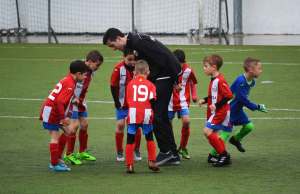
- Neurodiversity is a term coined by sociologist Judy Singer to refer to natural variations in the human brain, driven by epigenetics.
- The neurodiversity movement rejects the idea that people with ADHD, autism, and other neurodevelopmental conditions are somehow defective.
- As a society we need to value and accommodate neurodiverse children rather than placing an undue burden on individuals to change.
- Neurodiverse children can benefit from best practices like targeted therapy, strength-based approaches, and inclusive classrooms.
- We all flourish when neurodiverse children feel that they belong.
A toddler who gets overwhelmed when she hears a lawnmower. A kindergartner who can’t read your facial expressions. A grade-schooler who repeats the same phrase over and over. A teenager who will only wear one color. These can all be signs of neurodivergence: natural variations in the human brain.
At least one third of a human’s genetic material is encoded in the brain. This allows for a ton of natural variation in how people think, feel, and interact with others. Neurodiversity (aka neurodivergence) is a concept that both embraces these neurological differences and serves as an inclusive call to action. More precisely, the neurodiversity movement aims to abolish the idea that people with developmental conditions like autism spectrum disorder (ASD), attention deficit/hyperactivity disorder (ADHD), and sensory processing disorder need to be “cured.” Instead, advocates believe that:
1) Society as a whole needs to learn to accommodate people who are differently-abled, for the benefit of all.
2) Therapeutic interventions should focus on issues that are meaningful to the neurodiverse person, not on pathologizing or trying to change who someone is.
To understand neurodiversity, you first need to understand the basics about how our environment can influence which of our genes get expressed and which don’t. This is the science of epigenetics.

Epigenetics and the Pseudoscience of “Normalcy”
“The story of neurodiversity is immensely intertwined with the concept of epigenetics,” says Matt Shenker, MEd, licensed professional counseling resident at Thriveworks in Hanover, VA. Shenker specializes in working with kids who have the (often overlapping) symptoms of ADHD, autism, oppositional defiant disorder (ODD), anxiety, and unspecified trauma disorder. What causes these symptoms? Environmental variables like maternal health, air pollution, nutrition, toxins, trauma, and technology could all be contributing to the activation of certain heritable genes during neurodevelopment. The result is that some childrens’ brains operate in a way that isn’t neurotypical. But who, Shenker asks, “gets to define neurotypical”?
In “normal” human development, kids mature with the abilities to:
- Interact successfully with their peers
- Talk without major speech delays
- Tolerate change
- Not become overwhelmed by stimuli
- Regulate emotions
- Sustain attention
But you may see the problem here. Kids—just like adults—are wildly different. Their behavior varies to infinite degrees, for all sorts of reasons. And many of the traits that constitute “normalcy” are defined by society, not biology. There’s nothing inherently wrong with a child who struggles with soft skills like interpersonal communication. But within a society that doesn’t value and accommodate neurodiversity, that child might be at a disadvantage. And that’s where neurodiversity advocates try to step in.
Treating “Symptoms” vs. Reinforcing Strengths
Celebrating neurodiversity doesn’t mean that you can’t intervene to help a child succeed. It doesn’t mean that you let impulsive kids hit each other, or that you don’t try to teach social and emotional skills that will lead to more peer acceptance. Behavioral therapy is still a first-line treatment to improve executive functioning and enhance self-esteem for neurodiverse children.
But of course, there’s a wide spectrum of abilities in neurodiverse people. An autistic grade-schooler who hasn’t yet mastered the bathroom will have higher support needs than a child who harmlessly flaps his hands when he’s stressed or excited. Behavioral interventions should be targeted and based on what’s best for a child’s long-term wellbeing.
“Neurodiversity is only a problem when you take a fish and tell it to climb up the tree,” says Shenker. In inclusive environments that focus on a child’s strengths, social-emotional learning (SEL), and a sense of belonging, neurodiverse children can “find ways to connect.” Adults can draw attention to children’s skills, not their deficits. And all children will benefit from a setting that supports peoples’ differences.
Neurodiversity Best Practices
In addition to supporting neurodiverse kids with a strengths-based approach, neurotypical people can help exceptional children in the following ways:
- Give neurodiverse children the opportunity to express their own treatment goals whenever possible. Don’t assume that they’re inherently motivated to live a “good neurotypical life,” whatever that may be. Ask them what they need to succeed.
- According to Shenker, don’t “spend all your energy hunting for the exact right label.” Specific diagnoses can help guide treatment and allocate resources, but they can also medicalize natural differences. For example, at one point, homosexuality was listed as a disorder in the Diagnostic and Statistical Manual of Mental Disorders (DSM).
- Enlist objects and activities that make a child happy. For example, if a child loves dinosaurs, a teacher can use dinosaurs in lesson plans. It’s a way of speaking the child’s language.
- Appreciate a child’s natural coping strategies, even if they don’t look like yours.
- Place neurodiverse children in inclusive environments as much as possible. In classrooms, SEL can be taught incidentally, in real-time, alongside other content. This helps all children, not just the neurodiverse.
- For behavioral management, don’t use practices rooted in shame, fear, and control. Time-outs and detention can increase symptoms of anxiety because children tend to equate separation with being “a bad kid.” Instead, Shenker recommends “connection before redirection.”
- Continually affirm a child’s humanity. Make sure kids know that they’re not “too much” for a space. Show them that they’re respected and valued.
- Cultivate positive relationships and trust.
- For younger children, use behavioral therapy as a first-line intervention for ADHD, before medication.
- Encourage movement and mindfulness in children with ADHD. Exercise and meditation have been shown to benefit these kids, sometimes dramatically.
- Support research that seeks to understand how one’s environment can influence natural genetic variation.
- Give teachers better training on how to foster community and psychological safety in classrooms. “Measure how well a child’s needs are met,” says Shenker, “not just how well they retain info. We spent decades raising our standards of learning. Now it’s time to focus on raising our standards of care.”
- Be wary about pathologizing children, especially children of color. A recent study showed that teachers are more likely to identify Black and poor children as “high risk for a mental disorder.” Neurodiverse children of lower classes tend to be treated differently. Disorder frameworks can have an outsized impact on vulnerable kids.
- Try to preserve a child’s autonomy—their right to say “no.” Granted, this can be ethically complex as you try to define what constitutes 1) harm to a neurodiverse individual; and 2) a violation of someone else’s rights.
- Think about “goodness of fit” between people and environments. For example, look at the contrast between today’s highly structured classrooms and our ancestral habitats. Is it any wonder kids can’t sit still?
- Work to change institutions and environments rather than putting all the burden of responsibility on the neurodiverse individual. Let go of normative agendas and focus on a societal agenda. Even huge companies like Google are beginning to do this for neurodiverse adults.
- If you’re a caregiver, get the support you need. If you’re struggling to process a child’s diagnosis, give yourself time and space to adjust. Reach out to fellow parents. It’s enormously hard to deal with your child’s challenges, take care of yourself, and transform society, all at the same time.
Neurodiverse Kids and Belonging
Achieving mental health doesn’t equate to achieving “normalcy”. A large measure of mental health is connection to a community. We can help neurodiverse children reach their full potential through inclusion, destigmatization, and targeted therapies. Eventually, maybe the distinction of neurotypical vs. neurodivergent will fall away, and we will all be richer for belonging.













